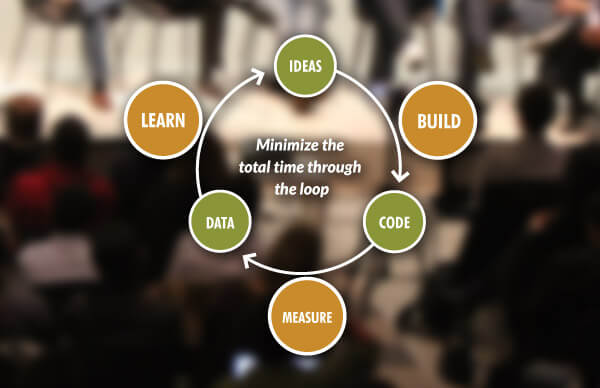The process of web analytics is ever-evolving! It’s the analytics data and its analysis that will help you improve your business, weave new strategies for it, and set new business goals. This is where the web analytics lifecycle comes into the picture. Unless you have a well-defined, repeatable web analytics life cycle in place, you can never improve your business bottom line.
Many business owners often commit the mistake of getting too much obsessed with the collection and reporting of any random analytics data about their website. Just because they read some outdated cookie-cutter blog post of the internet by some self-proclaimed analytics Guru! Ending up in ignoring the analysis of vital metrics that could have helped them accomplish their goals – faster.
A web analytics lifecycle (or just ‘cycle’) integrates the fundamentals of web analytics in a diagrammatic fashion. It enables you to iterate the processes in the diagram as many times you want until you achieve your desired goals. This cycle also allows you to discard the processes that aren’t working. But at the same time, it also helps you to improve upon those processes that move the needle of your business objectives. A web analytics cycle also allows you to modify your business goals if the data indicates that you are heading in the wrong direction.
Essentially, a simple and lean web analytics lifecycle will have four phases that allow you to improve a component in your business. For that, first, you must identify the part that you are looking to change in your business. Then you must devise a test case, execute it, and finally analyze the results. All of these should tell you where you are lacking, and help you decide on your next action plan.
But before we take the plunge, if you are still completely unaware of why you must use web analytics in your business, this video by Avinash Kaushik is worth watching!
Phase 1 – Identifying your problem area
A web analytics cycle cannot identify what’s lacking in your business. That’s up to you to find out! You must be well aware of the most vital processes of your business and how you are planning to modify them.
- Probably, it is a boost in the conversion rate that you want
- Or it’s an increase in the number of people signing up to your email newsletter
- Or maybe you need a higher number of social media shares
- Or you want to bring down the number of customers unsubscribing from your service (a.k.a. churn rate) every month
- Or in terms of brick and mortar business, you are looking to increase the number of visitors to your store!
The metric that you want to improve can only be figured out by you! If you have delegated that task of improving a metric to someone else, you must clearly convey what you want to improve. So, your role as a business owner in improving metrics is paramount. If you could move immensely closer to your business objectives after completing a full cycle, then your web analytics cycle was a success!
Choose a KPI (Key Performance Indicator)
Every business will have a set of KPIs that a business owner would like to measure. For example, if you run a pizzeria, then you will have the following KPIs associated with it.
- The number of people passing by your pizzeria
- The number of people stopping by to buy a pizza
- How much you will charge per pizza to breakeven or make a profit
Out of these three KPIs, you must select the most critical one. In this scenario, it is definitely the number of people buying pizzas. This KPI is now linked to a metric. The most appropriate metric for this KPI would be the Conversion Rate. And the price at which each Pizza is sold will be the target for the KPI.
The point is, you as a business owner must be clear about the metrics that you would like to improve. Each metric should have an associated KPI that you would like to measure. And each of the KPI must also have a target that you can treat as an accomplishment for your business.
Phase 2 – Create an assumption
You can plan a wide variety of assumptions for your business to find out how well your business is doing or to improve your business. It can be a marketing campaign, restructuring an application, changing the prices of your products, adding shipping cost for a purchase, a total makeover your website, switching to a different platform, changing the wordings of your CTAs (Call To Action) and buttons, or experimenting with a new feature etc. The possibilities are almost endless! Your imagination is the only limit! So you must try to get creative with this phase.
If your website or business is absolutely new, then there’s no way you can make use of historical data to see where your business is heading. In such a situation you can create assumptions based on the following aspects.
- Perform market research: You can do this by carrying out a survey, obtain customer feedback, or call your customers to obtain their feedback.
- Replicate your successful rivals: Try to adopt the same approach that your competitors are using to improve their bottom-line. There’s nothing wrong with emulating successful methodologies, even if it comes from your rivals. Reinvent the wheel only if it’s inevitable; else replicate a working system that produces results.
- Read success stories: You can learn a lot by reading the stories of successful entrepreneurs. Right from growing your users to cutting-edge content marketing techniques. They share crucial tips that helped them accomplish their goals in such stories. This will help you create a set of business best practices that you can rinse and repeat for your business.
But on the other hand, if your web analytics system has been generating data for some time then you can analyze that data to find out what’s working and what’s not. You can examine the user data to see if there are any common traits among those customers who are sticking around with your business.
Let’s imagine that you are trying to improve the number of subscribers to your email list. You will see some subscribers leaving your list (also known as Churn Rate) every month. Analyze what traits they share in common. And also examine your most devoted subscribers and try to find out what makes them stand apart from the others.
Once you have created these assumptions, it’s time to transform them into tests or experiments.

Phase 3 – Creating tests
Before turning your assumption into an experiment, you must find answers to these three vital questions.
1. Have you identified your target audience?
You may have an immaculately well-designed website for your business, but that’s useless if it doesn’t attract the right audience. If you see no improvement in your subscription rate or conversion rate despite a steady flow of visitors, probably they aren’t your target audience. So first you must identify your target audience and what you want them to do once they land on your site. You must find out how many of your visitors are your actual audience. If the percentage of your target audience is low, see how you can improve that. Until your website starts receiving the targeted traffic, it won’t bring any change to your business.
2. Do they know what their intended tasks are?
Does your website clearly communicate to your targeted audience what their intended tasks are? And most importantly, are they able to do it effortlessly? If not, can you identify the stumbling blocks? How many of your visitors have completed these tasks today?
3. Does your target audience have a reason to complete a task?
Why would your targeted visitors oblige to what you ask for? Are they benefited from doing something on your site? Do they find you trustworthy enough to finish a task that you ask them to do? Have you motivated them properly to stick around and do something on the site? Which calls-to-actions or appeals are seeing the best results?
These three questions may look easy to answer, but they aren’t! It’s hard for you to answer these questions unless you have a thorough knowledge of your customers. This type of customer knowledge is known as ‘Customer Development’ in the Lean Startups realm! Knowing the answers to these three queries are extremely vital to attaining (or improving) the KPI target that you have set.
The answers to these queries will equip you as a business owner to take appropriate actions at the right time. If you have created a great assumption or hypothesis, you are almost ready to conduct an effective experiment. But before executing the experiment, make sure you have all the analytics set up for the KPIs that you have defined. You must also have the starting point and target for your KPIs defined.
Yes, now you are all set to run the test!
Phase 4 – Analyze the results and decide on the next action plan
Once you enter this phase, you should have the test results, which you can assess to determine if the test was a success or not. This provides us with a number of choices!
- If the results are absolutely stellar, you have every reason to be happy, and also to reveal a bit in your victory. Your next step would be to pick the next vital metric that affects your business, and the next one, and keep iterating the cycle.
- If you’ve received undesirable test results, worry not! You just need to take a closer look at your assumption or hypothesis and tweak it and iterate the next steps in the cycle. If the failure helped you to learn something new, then it’s never a waste of time.
- If the test has created some positive ripples in your business, but not a complete success, then maybe you need to carry out a new test. But yes, the executed test can still produce the expected results, if you can run it after adjusting its parameters.
In a nutshell, a web analytics cycle is a neat tool that will surely help you improve your business bottom-line! It allows you to be clever, quick, and iterative. It helps you make a thoughtful plan, analyze its results, and hover closer to the target. And also iterate the cycle until you hit the bull’s eye!
But the web analytics cycle can provide you with accurate results only if you are equipped with a state-of-the-art web analytics tool. An analytics tool that can help you make the best judgment and take the most appropriate action – at the right time. FoxMetrics suite of analytics tool is one such tool that you can completely count on for your highly critical web analytics requirements.
FoxMetrics tools are absolutely not designed to spit out overwhelming amounts of analytics data at you, but carefully crafted to help you make the most informed business decisions. Yes, it spits out data, but useful ones that will help you put your business on the right track thanks to its complex and ingenious algorithm.
We at FoxMetrics have always strived hard to improve and customize our analytics tools for accomplishing the business goals for a wide range of clients across domains. Your business could be the next success story! So, integrate the FoxMetrics suite of tools to your business right now and witness how it can put your business on the path to success – almost instantly!!
If you’re thinking of personalizing the experience of your visitors, try FoxMetrics for free and Subscribe to our Newsletter get recent updates and news.

